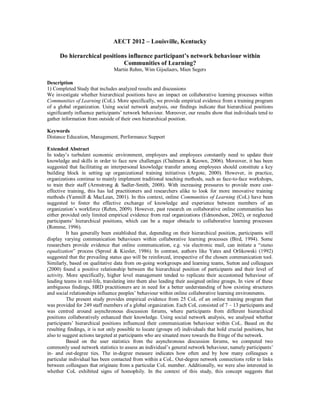
Do hierarchical positions influence participant’s network behaviour within Communities of Learning?
- 1. AECT 2012 – Louisville, Kentucky Do hierarchical positions influence participant’s network behaviour within Communities of Learning? Martin Rehm, Wim Gijselaers, Mien Segers Description 1) Completed Study that includes analyzed results and discussions We investigate whether hierarchical positions have an impact on collaborative learning processes within Communities of Learning (CoL). More specifically, we provide empirical evidence from a training program of a global organization. Using social network analysis, our findings indicate that hierarchical positions significantly influence participants’ network behaviour. Moreover, our results show that individuals tend to gather information from outside of their own hierarchical position. Keywords Distance Education, Management, Performance Support Extended Abstract In today’s turbulent economic environment, employers and employees constantly need to update their knowledge and skills in order to face new challenges (Chalmers & Keown, 2006). Moreover, it has been suggested that facilitating an interpersonal knowledge transfer among employees should constitute a key building block in setting up organizational training initiatives (Argote, 2000). However, in practice, organizations continue to mainly implement traditional teaching methods, such as face-to-face workshops, to train their staff (Armstrong & Sadler-Smith, 2008). With increasing pressures to provide more cost- effective training, this has led practitioners and researchers alike to look for more innovative training methods (Yamnill & MacLean, 2001). In this context, online Communities of Learning (CoL) have been suggested to foster the effective exchange of knowledge and experience between members of an organization’s workforce (Rehm, 2009). However, past research on collaborative online communities has either provided only limited empirical evidence from real organizations (Edmondson, 2002), or neglected participants’ hierarchical positions, which can be a major obstacle to collaborative learning processes (Romme, 1996). It has generally been established that, depending on their hierarchical position, participants will display varying communication behaviours within collaborative learning processes (Bird, 1994). Some researchers provide evidence that online communication, e.g. via electronic mail, can initiate a “status equalization” process (Sproul & Kiesler, 1986). In contrast, authors like Yates and Orlikowski (1992) suggested that the prevailing status quo will be reinforced, irrespective of the chosen communication tool. Similarly, based on qualitative data from on-going workgroups and learning teams, Sutton and colleagues (2000) found a positive relationship between the hierarchical position of participants and their level of activity. More specifically, higher level management tended to replicate their accustomed behaviour of leading teams in real-life, translating into them also leading their assigned online groups. In view of these ambiguous findings, HRD practitioners are in need for a better understanding of how existing structures and social relationships influence peoples’ behaviour within online collaborative learning environments. The present study provides empirical evidence from 25 CoL of an online training program that was provided for 249 staff members of a global organization. Each CoL consisted of 7 – 13 participants and was centred around asynchronous discussion forums, where participants from different hierarchical positions collaboratively enhanced their knowledge. Using social network analysis, we analysed whether participants’ hierarchical positions influenced their communication behaviour within CoL. Based on the resulting findings, it is not only possible to locate (groups of) individuals that hold crucial positions, but also to suggest actions targeted at participants who are situated more towards the fringe of the network. Based on the user statistics from the asynchronous discussion forums, we computed two commonly used network statistics to assess an individual’s general network behaviour, namely participants’ in- and out-degree ties. The in-degree measure indicates how often and by how many colleagues a particular individual has been contacted from within a CoL. Out-degree network connections refer to links between colleagues that originate from a particular CoL member. Additionally, we were also interested in whether CoL exhibited signs of homophily. In the context of this study, this concept suggests that
- 2. participants from the same hierarchical position would tend to communicate more frequently within their own subgroup. In order to approximate this effect, we used the external-internal (E-I) index. Moreover, we subdivided the data according to “Read-“ and “Reply- networks”, capturing passive and active learning behaviours, respectively. The attained data was then used to test the following research hypotheses: · H1: Participants' hierarchical positions will have a positive influence on their amount of out- degree network ties. · H2: Participants' hierarchical position will have a positive influence on their amount of in-degree network ties. · Hypothesis 3: Participants will tend to interact more with colleagues from the same hierarchical position. While we do not find evidence to support the first two hypotheses for the “Read-networks”, we are able to show significant differences in participants’ network behaviour for the “Reply-networks”. More specifically, participants from higher up the hierarchical ladder tended to be more active in connecting with other colleagues, as well as attracting more attention within the CoL. We are also able to show that the CoL are not subject to homophily. Quite on the contrary, our results indicate a general tendency of hierarchical positions to gather information from outside their own subgroup. Taken together, our study provides valuable insights for HRD practitioners that consider the implementation of similar training initiatives. The empirical results clearly indicate that hierarchical positions are transferred into the virtual realm and that higher level management plays an important role in CoL. By incorporating these insights into the implementation of future CoL, it is not only possible to anticipate participants’ behaviour. Our findings also allow to draw conclusions about how collaborative learning activities within CoL should be designed and facilitated, in order to provide employees with a valuable learning experience. Moreover, we are able to show that CoL foster interpersonal knowledge transfer across hierarchical positions, which allows organizations to create a fruitful learning environment where thoughts are exchanged and new ideas can be created.
